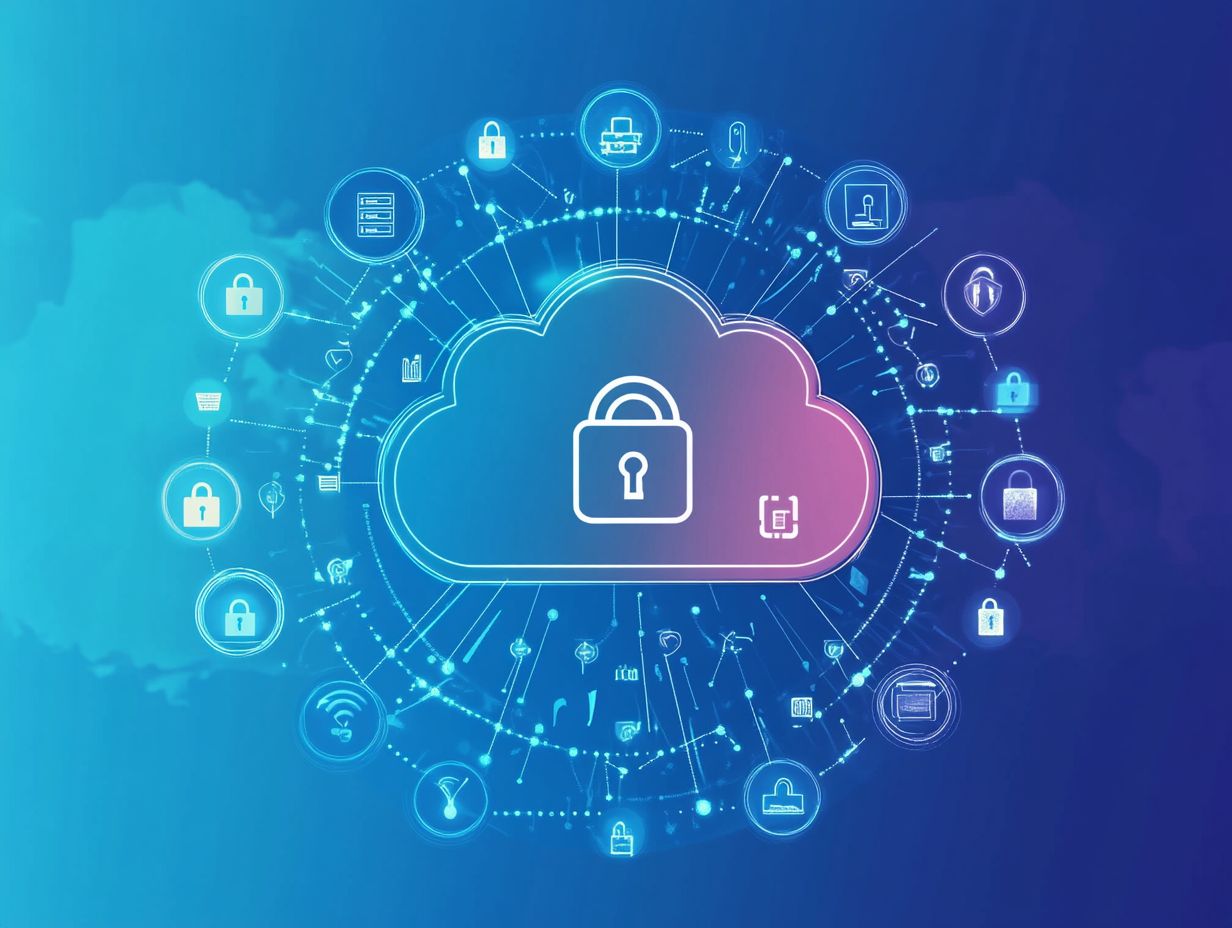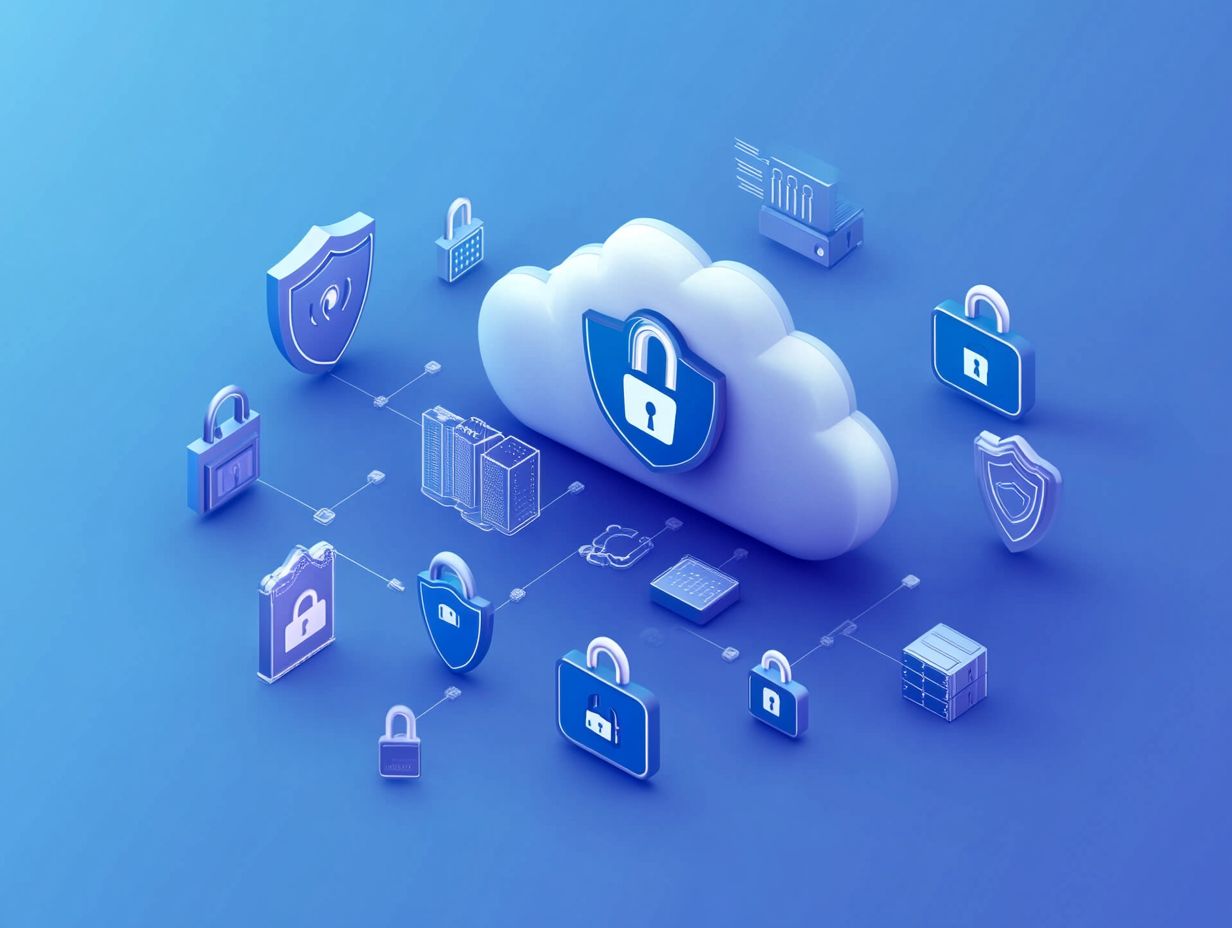5 Cloud Security Challenges for 2024
As your business increasingly relies on cloud technology, the importance of strong cloud security cannot be overstated.
Navigating the complexities of cloud environments presents various challenges, including threats ranging from data breaches and cyber attacks to the often-overlooked risks posed by insider threats. These issues expose your organization to multiple vulnerabilities.
This article explores five critical cloud security challenges for 2024, providing insights on best practices, compliance strategies, and the latest technologies to protect your business.
Get ready to elevate your cloud security approach as we confront these pressing issues!
Contents
- Key Takeaways:
- 1. Data Breaches and Cyber Attacks
- 2. Lack of Control and Visibility
- 3. Compliance and Regulatory Issues
- 4. Insider Threats
- 5. Integration and Compatibility Issues
- How Can Businesses Prepare for These Challenges?
- Preguntas Frecuentes
- Cu les son los 5 principales desaf os de seguridad en la nube para 2024?
- C mo se pueden prevenir las violaciones de datos en la nube?
- Por qu la falta de visibilidad y control es un desaf o importante de seguridad en la nube?
- C mo se pueden abordar los problemas de cumplimiento y regulaci n en la nube?
- Cu les son algunas configuraciones incorrectas comunes en la nube que pueden llevar a riesgos de seguridad?
- C mo pueden las organizaciones protegerse contra amenazas internas en la nube?
Key Takeaways:

Data breaches and cyber attacks will continue to be major security challenges for businesses using cloud services in 2024. The 5 cloud security challenges for businesses highlight the lack of control and visibility in the cloud environment, which can make it difficult for companies to protect their data and systems. Compliance and regulatory issues will become more complex as more businesses adopt cloud services, requiring careful planning and implementation.
1. Data Breaches and Cyber Attacks
Data breaches and cyber attacks are increasingly common in today’s cloud security landscape, posing significant threats to organizations across various sectors. Staying informed about the top trends in cloud migration for 2024 can help mitigate the potential for substantial financial losses, reputational harm, and legal ramifications.
As cyber threats evolve, including sophisticated phishing schemes and advanced AI-driven tactics, you must prioritize your security strategies NOW to stay ahead of these challenges. The prevalence of data breaches highlights the critical need for incident response plans and tools, like those provided by CrowdStrike, to effectively mitigate risks.
Recent statistics reveal that a staggering 70% of organizations experienced a data breach in 2022, emphasizing the urgency of this issue. High-profile incidents, such as the massive breach at a leading healthcare provider that impacted millions of patients, serve as stark reminders of the severe consequences these threats can bring.
With the average cost of a data breach now exceeding $4 million, the financial fallout is staggering.
Adopting best practices for incident response is essential. Implementing continuous monitoring and integrating advanced AI technologies will facilitate rapid threat identification and ensure a robust defense against future incidents.
Taking proactive steps in cybersecurity is vital to keep your organization safe from the ever-evolving landscape of cyber threats.
2. Lack of Control and Visibility
The lack of control and visibility in cloud environments can leave you grappling with inadequate change control, making identity management a critical concern as you strive for cloud compliance.
When you’re unable to effectively monitor your cloud infrastructure, you open the door to significant security challenges. This situation invites unauthorized access, allowing malicious actors to exploit vulnerabilities. To stay ahead of potential risks, it’s crucial to keep an eye on the top hybrid cloud trends to watch in 2024, which can help mitigate data breaches and compliance violations.
It s essential to implement robust security strategies that enhance visibility. Utilizing cloud monitoring tools can offer real-time insights into user activity and resource changes, while strong identity management solutions ensure that only authorized personnel can access sensitive data.
By maintaining stringent security protocols, you can significantly mitigate risks, fostering a safer cloud environment that not only protects your valuable assets but also supports compliance with regulatory standards.
Are you ready to evaluate your cloud security strategies?
3. Compliance and Regulatory Issues
Compliance and regulatory issues in cloud security are critical for organizations like yours that operate under stringent frameworks such as GDPR, PCI, and HIPAA. Understanding your compliance requirements is crucial.
These regulations come with a host of obligations regarding data handling, consent management, and incident reporting. All of these play a significant role in shaping your cloud security strategies.
Navigating the compliance landscape isn t without its challenges. You ll need to ensure consistent data protection, manage third-party risks, and maintain transparency in your data processing practices.
To effectively comply with these regulations, act now by adopting best practices that include:
- Implementing strong ways to protect data
- Conducting regular vulnerability assessments
- Establishing comprehensive incident response plans
Regular audits will help you identify potential compliance gaps. They also strengthen a culture of accountability within your organization.
This proactive approach enables you to safeguard sensitive information while staying ahead of evolving regulatory demands.
4. Insider Threats

Insider threats represent a significant risk to cloud security. Employees with legitimate access can inadvertently or maliciously compromise sensitive data, potentially leading to serious data breaches.
These threats typically fall into two primary categories: negligent and malicious. Negligent insider threats often emerge from employees who mishandle sensitive information due to careless actions, like neglecting to follow security protocols or succumbing to phishing scams.
Conversely, malicious insiders intentionally exploit their access to inflict harm or steal data for personal gain. To effectively combat these risks, it s essential for organizations to implement robust access management systems.
These systems ensure that only authorized personnel can access sensitive information. Coupled with regular employee training sessions focused on security best practices, these measures can significantly enhance overall security.
Regularly monitoring user behavior and conducting thorough audits can help identify anomalies. This allows for prompt intervention to mitigate potential insider threats before they escalate.
5. Integration and Compatibility Issues
Integration and compatibility issues in cloud security can significantly impede your ability to implement effective security strategies. This is especially true when embracing multiple cloud services without proper AWS optimization or a keen awareness of Shadow IT, making it crucial to consider the top cloud security tools for 2024.
These challenges complicate management and expose you to a range of security risks. To mitigate these issues, it’s crucial to be aware of the 5 dangerous cloud security threats that may arise, as disparate services may fail to communicate effectively, creating vulnerabilities.
When your security tools are poorly equipped to function in harmony, the likelihood of data breaches and compliance violations rises dramatically. To navigate these complexities, adopt a well-architected framework tailored for cloud environments.
This approach involves centralizing your security management and ensuring that all tools are seamlessly integrated. This effectively eliminates any gaps in coverage.
Continuous monitoring and routine assessments are also crucial for maintaining a secure cloud landscape. This allows you to thwart potential threats before they escalate.
How Can Businesses Prepare for These Challenges?
You can prepare for the multifaceted challenges of cloud security by implementing robust strategies. Focus on threat detection, continuous monitoring, and developing effective incident response plans. Staying informed about key trends in IaaS for 2024 will enable you to swiftly address potential breaches.
By taking these steps, you’ll be better equipped to navigate the complexities of the ever-evolving digital landscape. Investing in advanced technologies, such as artificial intelligence, is crucial. It significantly enhances your ability to identify and respond to potential threats in real time.
This proactive approach streamlines your incident response efforts. It also mitigates risks by ensuring that vulnerabilities are addressed before they escalate into severe issues.
Regular training and awareness programs for your staff can further strengthen your security infrastructure. Make sure everyone understands their role in protecting sensitive data from emerging threats.
What Are the Best Practices for Cloud Security?
Implementing best practices for cloud security is crucial to safeguard your assets and mitigate risks associated with data breaches. This includes using two-step sign-in and managing encryption keys with precision.
Regularly updating your software can help patch vulnerabilities swiftly, closing off potential entry points for attackers. Conducting audits and constant monitoring can uncover risky behavior or unauthorized access, enabling timely intervention.
By incorporating comprehensive training programs, you can educate your employees to recognize phishing attempts and other cyber threats. Collectively, these practices create a fortified cloud infrastructure that is resilient to cyber threats.
Don’t leave your data unprotected! These measures ensure that your data remains safe and regulatory compliance is upheld.
How Can Businesses Ensure Compliance in the Cloud?

To ensure compliance in the cloud, you must adopt clear plans that follow legal rules such as GDPR, PCI, and HIPAA. This ensures that all your data handling meets legal requirements.
These plans should include regular compliance audits to assess your adherence to regulations and identify potential vulnerabilities. Proactive staff training programs equip your employees with a solid understanding of compliance obligations and data protection practices.
Stay informed about ongoing regulatory changes to ensure that your procedures remain effective and relevant. By selecting cloud solutions with built-in compliance features, you can simplify the process and manage compliance obligations more efficiently and reliably.
What Are the Latest Technologies for Cloud Security?
The latest technologies in cloud security leverage advanced AI and innovative solutions like Cyscale and Mandiant to elevate your threat detection and continuous monitoring capabilities. These cutting-edge technologies offer you a powerful chance to boost your security against ever-evolving cyber threats.
By integrating these state-of-the-art tools into your security framework, you can enhance your incident response times. Smart computer programs analyze vast amounts of data quickly and learn from previous threats, allowing you to identify vulnerabilities before they can be exploited.
Real-time monitoring systems create an adaptive defense mechanism that evolves with new threats, ensuring your operations remain secure. As these groundbreaking technologies proliferate, they provide invaluable opportunities to strengthen your security posture and uphold the confidentiality, integrity, and availability of your data.
How Can Businesses Address Insider Threats in the Cloud?
To effectively tackle insider threats in the cloud, implement comprehensive access management protocols. Access management means controlling who can see and use important information, ensuring that only authorized personnel have access to sensitive data.
This strategic approach sets the foundation for a robust security framework that also calls for regular security training for your employees. By fostering a culture of vigilance and awareness around potential risks, you create an environment where everyone is attuned to security concerns.
Continuously educating your staff about the ever-evolving threat landscape gives them the power to recognize suspicious behavior and uphold security protocols. Utilizing monitoring tools enhances oversight, allowing cybersecurity professionals to detect anomalies and respond quickly to potential breaches.
These experts play a vital role in crafting effective countermeasures, promoting an environment where insider threats are addressed proactively rather than reactively. Act now to secure your cloud!
What Are the Common Misconceptions About Cloud Security?
Common misconceptions about cloud security can lead you to underestimate the risks of data breaches and the critical importance of implementing challenges in cloud security with robust measures tailored to cloud environments.
You might think your cloud provider is solely responsible for securing your data, which creates a misleading sense of security. You must understand that cloud security operates on a shared responsibility model. This means both you and your provider play a role in security. While providers are tasked with ensuring the safety of the infrastructure, the responsibility for securing applications, data, and user access rests with you. This misunderstanding can result in inadequate defenses against threats, leaving vulnerabilities that could be easily exploited.
To effectively protect your valuable information, it s imperative to take proactive measures, such as:
- Implementing strong encryption, which makes data unreadable to unauthorized users
- Conducting regular security assessments
- Fostering a security-aware culture among your employees
Preguntas Frecuentes

Cu les son los 5 principales desaf os de seguridad en la nube para 2024?
Los 5 principales desafíos de seguridad en la nube para 2024 son las violaciones de datos, la falta de visibilidad y control, los problemas de cumplimiento y regulación, las configuraciones incorrectas y las amenazas internas.
C mo se pueden prevenir las violaciones de datos en la nube?
Las violaciones de datos en la nube se pueden prevenir implementando controles de acceso s lidos, realizando auditor as de seguridad regulares y utilizando encriptaci n de datos sensibles. Use autenticaci n de m ltiples factores y limite el acceso solo al personal necesario para ayudar a prevenir violaciones de datos.
Por qu la falta de visibilidad y control es un desaf o importante de seguridad en la nube?
La falta de visibilidad y control en la nube puede llevar a una falta de comprensi n sobre qu datos se est n almacenando, qui n tiene acceso a ellos y c mo se est n utilizando. Esto puede dificultar la detecci n y respuesta a posibles amenazas de seguridad.
C mo se pueden abordar los problemas de cumplimiento y regulaci n en la nube?
Los problemas de cumplimiento y regulaci n se pueden abordar en la nube implementando pol ticas de seguridad estrictas, revisando y actualizando regularmente estas pol ticas, y utilizando herramientas de cumplimiento de terceros. Tambi n es importante mantenerse actualizado sobre cualquier cambio en las regulaciones y garantizar su cumplimiento.
Cu les son algunas configuraciones incorrectas comunes en la nube que pueden llevar a riesgos de seguridad?
Las configuraciones incorrectas comunes en la nube incluyen dejar los buckets de almacenamiento de datos o bases de datos abiertas al p blico, controles de acceso inadecuados y no actualizar regularmente software y parches de seguridad. Estas configuraciones incorrectas pueden dejar los datos sensibles vulnerables a ataques cibern ticos.
C mo pueden las organizaciones protegerse contra amenazas internas en la nube?
Las organizaciones pueden protegerse contra amenazas internas en la nube implementando controles de acceso s lidos, monitoreando y auditando regularmente la actividad de los usuarios, y proporcionando capacitaci n exhaustiva sobre protocolos de seguridad a todos los empleados. Tambi n es importante tener un plan para responder y mitigar amenazas internas.
Stay secure in the cloud start implementing these tips today!






